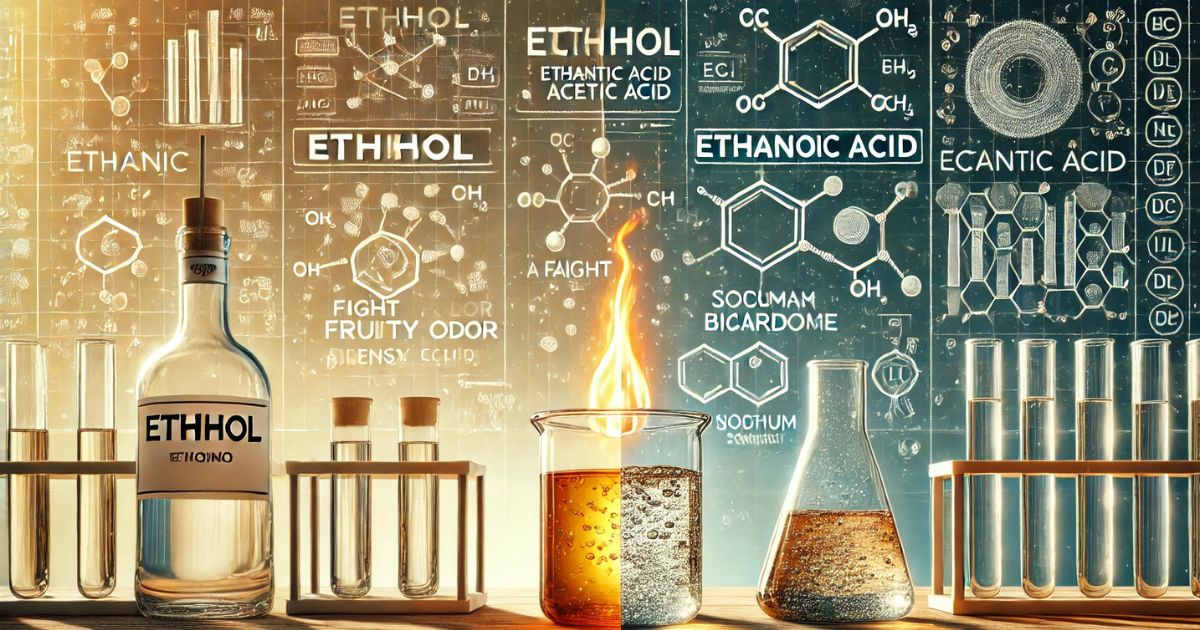
Ethanol and ethanoic acid are both simple organic compounds, but they have distinct properties that set them apart. Here are some key differences that help you tell them apart:
1. Chemical Structure
- Ethanol (C₂H₅OH):
- Consists of a two-carbon chain with a hydroxyl (–OH) group attached.
- It is an alcohol.
- Ethanoic Acid (CH₃COOH):
- Contains a two-carbon chain where one carbon is part of a carboxyl (–COOH) group.
- It is a carboxylic acid.
2. Physical Properties
- Ethanol:
- Odor: Has a characteristic alcoholic smell.
- Taste: Slightly sweet.
- Boiling Point: About 78°C.
- Solubility: Highly miscible with water.
- Uses: Widely used as a solvent, fuel, and in beverages.
- Ethanoic Acid:
- Odor: Possesses a pungent, sour smell (similar to vinegar).
- Taste: Sour.
- Boiling Point: Around 118°C.
- Solubility: Also soluble in water, but its acidity influences its interactions.
- Uses: Main component of vinegar and used in chemical synthesis.
3. Acid-Base Properties
- Ethanol:
- Acidity: Ethanol is essentially neutral; it does not donate a proton easily.
- Reactivity: Does not react with bases to produce salts.
- Ethanoic Acid:
- Acidity: It is a weak acid (pKa ~4.76) and can donate a proton (H⁺) from its carboxyl group.
- Reactivity: Reacts with bases (such as sodium bicarbonate) to form acetate salts and carbon dioxide.
4. Simple Chemical Tests
One common test to distinguish between them is to use a basic solution such as sodium bicarbonate (baking soda):
- Test with Sodium Bicarbonate:
- Ethanoic Acid:
When mixed with sodium bicarbonate, ethanoic acid reacts to form sodium acetate, water, and carbon dioxide. You will observe bubbling (effervescence) due to the release of CO₂: CH3COOH+NaHCO3→CH3COONa+H2O+CO2↑\text{CH}_3\text{COOH} + \text{NaHCO}_3 \rightarrow \text{CH}_3\text{COONa} + \text{H}_2\text{O} + \text{CO}_2 \uparrow - Ethanol:
Ethanol does not react with sodium bicarbonate; no bubbling occurs.
- Ethanoic Acid:
5. Practical Applications and Uses
- Ethanol:
- Applications: Used in beverages, as a disinfectant, fuel, and solvent in various industries.
- Handling: It is flammable and should be handled with care.
- Ethanoic Acid:
- Applications: Primarily used in the production of vinegar, as a food additive, and in the chemical industry for making polymers and other chemicals.
- Handling: It is corrosive and should be handled with appropriate safety measures (gloves, goggles, etc.).
Conclusion
In summary, ethanol and ethanoic acid can be differentiated by their:
- Chemical Structure: Ethanol is an alcohol (–OH group), while ethanoic acid is a carboxylic acid (–COOH group).
- Physical Properties: Ethanol has an alcoholic odor and is less acidic, whereas ethanoic acid has a sour, pungent smell.
- Acidic Nature: Ethanoic acid can donate a proton and reacts with bases like sodium bicarbonate, producing effervescence, while ethanol does not.
- Uses: Ethanol is widely used in beverages and as a solvent, while ethanoic acid is used mainly in vinegar and chemical synthesis.
These differences not only help in laboratory identification but also explain their varied roles in everyday life and industrial applications.
Also Check:
• How Can Ethanol and Ethanoic Acid Be Differentiated? A Comprehensive Guide for Class 10
• How Can Baking Soda Be Converted into Baking Powder? An In-Depth Exploration
• How Can Tapetal Cells Become Binucleate? An In-Depth Exploration
• How Can a Saturated Solution Be Made Unsaturated? A Comprehensive Guide



